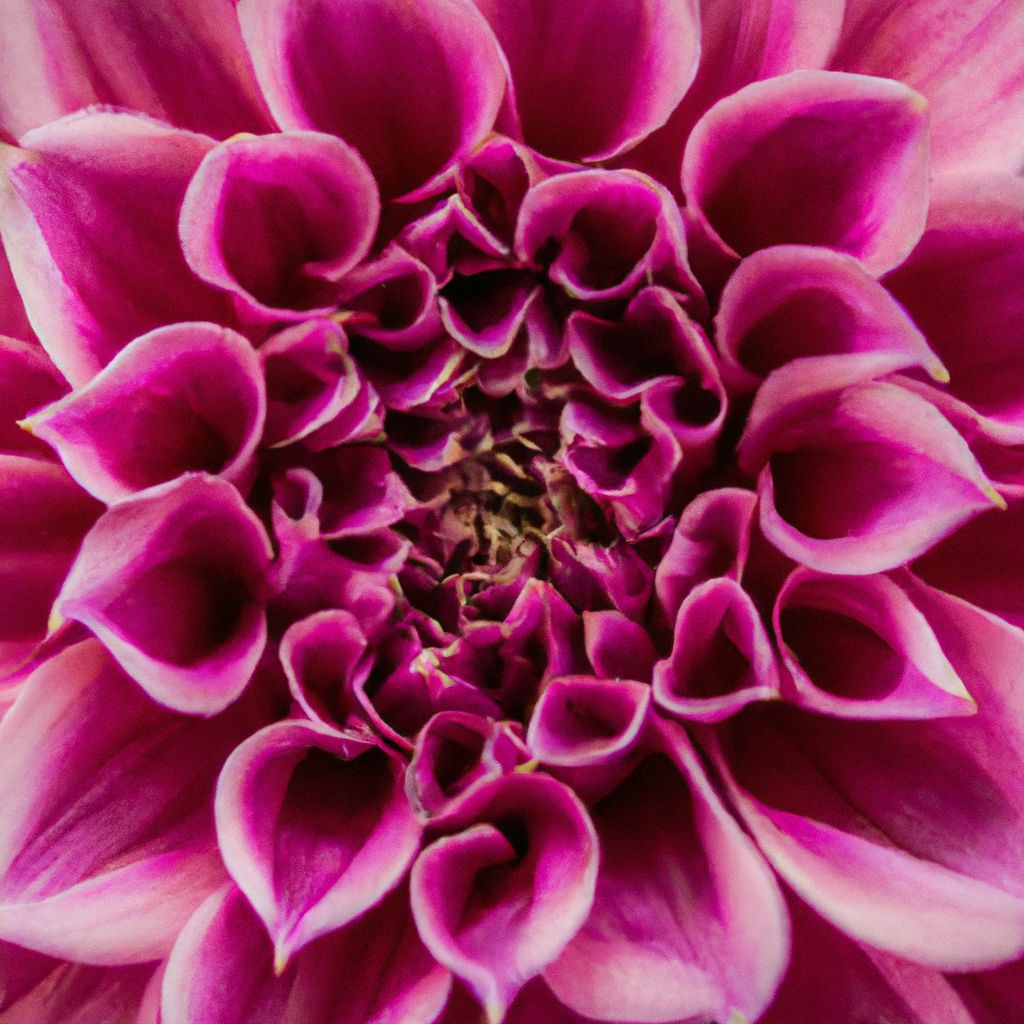Key Takeaways:
- Dinnerplate dahlias are popular among gardeners for their large and showy blooms.
- Proper planting and care are essential for optimal growth and blooming of dinnerplate dahlias.
- Choosing the right time to plant and selecting an ideal location with all-day sun and well-drained soil are crucial for the success of dinnerplate dahlias.
- Watering about an inch per week and regular fertilizing with a liquid all-purpose fertilizer are important for the proper nourishment of dinnerplate dahlias.
- Providing support and staking the plants early on help prevent damage from wind and rain.
- Regularly deadheading and picking flowers promote more blooms and prevent pests and disease.
- When caring for dinnerplate dahlias, consider their height and placement in the garden and ensure proper overwintering in cold climates.
- Protect dinnerplate dahlias from pests and diseases, such as Japanese beetles, and make use of physical barriers or insecticidal soap if necessary.
- Dinnerplate dahlias are ideal for large-scale floral arrangements, such as centerpieces and flower arches.
Introduction
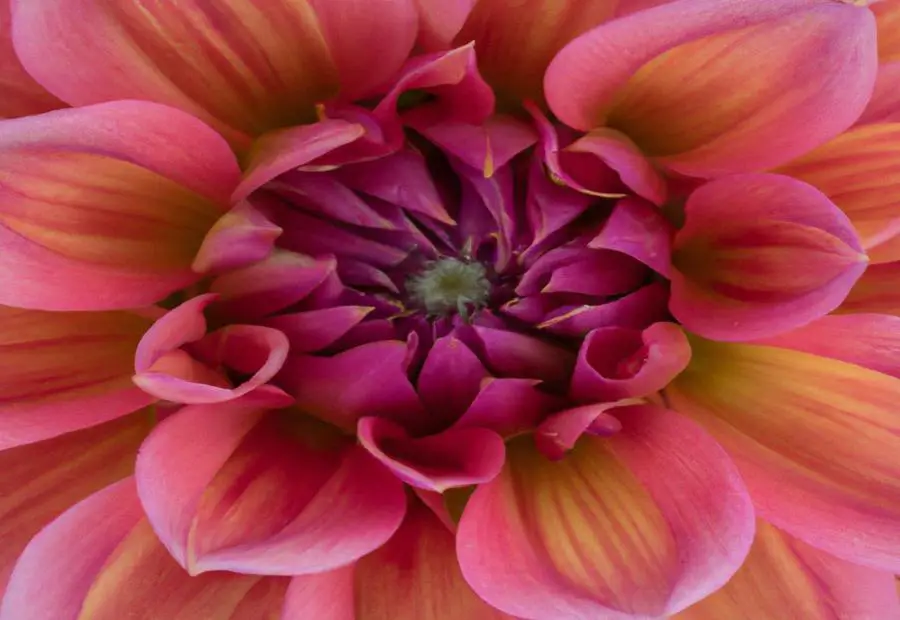
Photo Credits: Fortheloveofgardeners.Com by Joe Perez
Dinner plate dahlias are captivating blooms that have gained immense popularity among gardeners. In this section, we’ll dive into what makes these dahlias so special and why they have become a favorite choice for flower enthusiasts. Additionally, we’ll discuss the importance of proper planting techniques and care to ensure the optimal growth of these stunning dinner plate dahlias. Get ready to discover the beauty and secrets behind these magnificent flowers!
Explanation of dinnerplate dahlias and their popularity among gardeners
Dinnerplate dahlias are the envy of other flowers! Gardeners love ’em for their size and vibrancy. These blooms measure up to 12 inches across! They add beauty and elegance to any outdoor space or floral arrangement.
It’s essential to plant them right. After the danger of frost passes, or start ’em in pots. Give ’em all-day sun and well-drained soil. Plus, one inch of water and liquid fertilizer each week. Stake ’em too, to guard against wind and rain.
Deadheading and picking flowers regularly helps. Cut ’em when open, before petals start to soften. This stops pests and diseases. Consider their height though – they can be 4 feet tall! Place in the back of a flower bed or cutting garden. In cold climates, overwinter indoors.
Protect against pests with physical barriers or insecticidal soap. Also great for large-scale floral arrangements like centerpieces and flower arches. Dinnerplate dahlias: a beautiful display when proper planting and care come together!
Importance of proper planting and care for optimal growth
Time and location are key for optimal growth of dinnerplate dahlias. Gardeners love them for their colorful blooms! Plant outdoors once frost danger passes, or start in pots for earlier blooms. The ideal spot has all-day sun exposure, plus well-drained soil.
Water and fertilize with a liquid all-purpose fertilizer for robust growth. Stake and tie early to withstand strong winds and heavy rain. Deadheading encourages more blooms and prevents spread of pests and diseases. They can grow to 4 feet tall, so place in back of flower beds.
For cold climates, store indoors during winter. Pest and disease prevention is paramount. Also perfect for large floral arrangements. Plant and grow – green thumbs meet floral fever dreams!
Planting and Growing Dinnerplate Dahlias
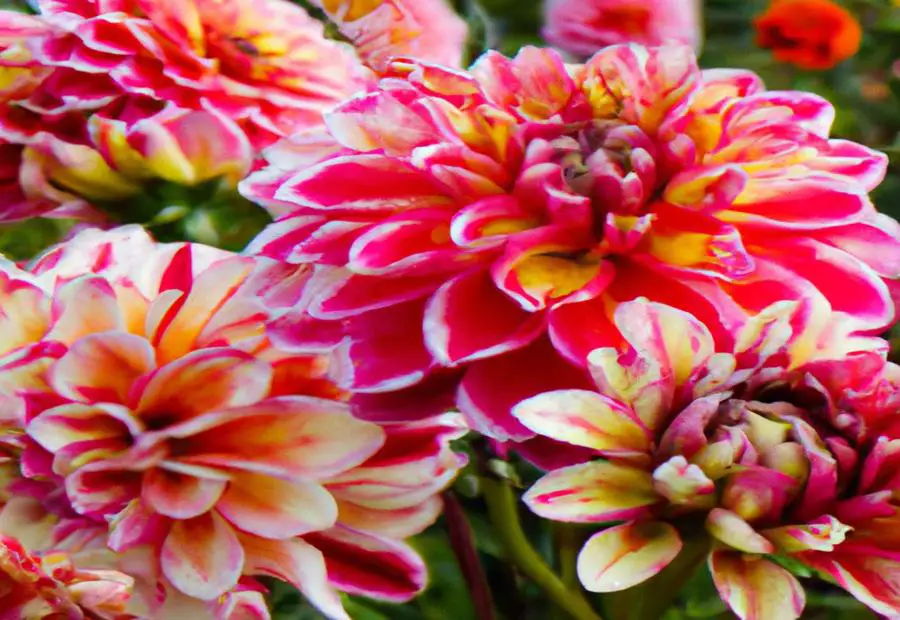
Photo Credits: Fortheloveofgardeners.Com by Noah Roberts
Planting and growing dinnerplate dahlias is a rewarding endeavor that requires careful consideration. From choosing the right time to plant and selecting an ideal location to watering, fertilizing, supporting, staking, and maintaining the plants, each step plays a crucial role in achieving beautiful blooms. By implementing proper practices, you can ensure a stunning display of dinnerplate dahlias in your garden.
Choosing the right time to plant
Gardeners love dinnerplate dahlias for their big, beautiful blooms. To get the best growth, the perfect planting time is essential.
Outdoors, wait until the risk of frost has gone. This usually happens in spring when temperatures are warm enough.
For earlier blooms, pot them up indoors first. This way, you can start them off before it’s safe to move them outside.
When selecting a spot, make sure they get all-day sun. These flowers need plenty of sunlight to grow well and produce bright blooms.
Plus, good drainage is a must. This prevents root rot and other problems.
Watering and fertilizing are key to caring for dinnerplate dahlias.
Water an inch per week for the right amount of moisture. And use a liquid all-purpose fertilizer regularly for healthy growth.
Support and stake your plants early too. Stake them as soon as they start growing to keep them from falling over. Tie the stems to stakes as they grow to keep them safe from wind and rain.
Regularly deadhead and pick flowers to get more blooms. Picking them when they open and before their back petals soften creates longer-lasting arrangements. Removing spent flowers also stops pests and diseases spreading.
After surviving the cold, dinnerplate dahlias are ready to blossom! Choose the right time to plant them for successful growth.
Planting outdoors after the danger of frost has passed
Plant dinnerplate dahlias outdoors after the threat of frost has passed for optimal growth. Frost can damage their delicate blooms and prevent them from flourishing.
Follow these steps for planting:
- Choose a sunny location.
- Prepare the soil with organic matter.
- Dig a hole 6 inches deep.
- Make sure the eye (bud) faces up when you put the tuber in the hole.
- Firmly cover the tuber with soil.
Water and fertilize regularly. Give one inch of water per week and use liquid all-purpose fertilizer.
These plants can grow up to 4 feet tall, so position them at the back of flower beds or in cutting gardens. In cold climates, store them indoors during winter to prevent freezing.
Gardeners have learned over time that delaying outdoor planting until after the last frost date helps the plants succeed. By understanding the risk of early spring frosts, gardeners have created guidelines for planting these flowers outdoors.
Starting them in pots for earlier blooming
Starting dinnerplate dahlias in pots is a great way to bloom earlier. Pots give a flexible, controlled environment. Choose sturdy pots with drainage holes and fill with well-drained soil and organic matter. Plant the dahlia tubers 2 inches deep, one tuber per pot. Place the pots in a sunny location. Water regularly, keeping soil moist but not wet.
This gives dahlias a head start in growth and development. It also makes it easier to monitor and maintain individual plants. Perfect for large-scale floral arrangements or centerpieces. Pot sizes can suit specific needs.
Select robust varieties suited for container gardening. Examples: Café Au Lait, Kelvin Floodlight, Labyrinth, Pomona, Strawberry Fair, Spartacus, Sunburst, Tahiti, Lavender Perfection, and Emory Paul. Each variety has unique characteristics and colors.
By following these steps, gardeners can showcase their skills with stunning floral displays before traditional planting. Enjoy beautiful dinnerplate dahlias early!
Selecting the ideal location
When deciding the right spot for dinnerplate dahlias, there’s a few things to keep in mind.
- Sunlight is key; they need all-day sun to thrive.
- The soil should be well-drained, to avoid root rot or disease.
Take into account their height; they can grow up to 4 feet tall. Put them in the back of the flower bed, or in a cutting garden. That way, they won’t obscure other plants.
Protect dinnerplate dahlias from pests and diseases. Use physical barriers or insecticidal soap to fend off Japanese beetles. Keep them healthy and vibrant!
Add a splash of elegance and charm by using them in floral arrangements, like centerpieces or arches. Their striking size and colors make them perfect for eye-catching displays.
Follow these guidelines to ensure dinnerplate dahlias look amazing in your garden or arrangement. Enjoy their stunning visual impact!
Need for a prime location with all-day sun
Dinnerplate dahlias crave prime spots which bask in all-day sunlight for optimal growth. Sunlight is super important, as it directly affects the plant’s ability to make vibrant and abundant blooms. If they get enough sun, dinnerplate dahlias will be strong and have greater blooming capabilities.
To make sure dinnerplate dahlias receive enough sunshine, pick a planting location with no shade from buildings, trees, or plants. The ideal spot should have direct sunlight for 6 to 8 hours daily.
In addition to sun, it is also essential to consider the soil quality when choosing a prime spot for dinnerplate dahlias. The soil should be well-drained to avoid waterlogging and support healthy root growth. Poorly drained soil can lead to root rot and harm the plant’s overall growth and health.
By selecting a prime location that offers full sun and well-drained soil, gardeners can create a perfect environment for their dinnerplate dahlias to thrive and produce stunning blooms during the growing season.
History reveals that dinnerplate dahlias have usually been grown in spots with all-day sun. Gardeners have picked places without any shade from buildings or trees to ensure uninterrupted sunshine. This practice has been passed down through generations as it has been seen that these dahlias flourish when they get lots of sunlight. In addition, experienced gardeners have also noted the importance of well-drained soil in promoting healthy growth and beautiful blooms in these dahlias.
Well-drained soil for optimal growth
For dinnerplate dahlias to grow optimally, proper soil drainage is a must. Data shows how important it is for these flowers to have well-drained soil.
Well-drained soil is key for dinnerplate dahlia progress. This soil allows extra water to move away from the roots, stopping them from being water-filled and encouraging optimal growth.
- Well-drained soil stops too much water collecting around the roots which can cause root rot and other fungal diseases.
- Good drainage also assists oxygen availability, essential for root breathing and overall plant health.
- A well-drained soil structure helps the plant’s roots absorb nutrients, leading to strong growth and stunning blooms.
Gardeners can take various steps for proper drainage:
- Amending heavy clay or compacted soils with organic matter like compost or peat moss makes drainage better by breaking up dense soil particles.
- High beds or mounds can be built to help natural drainage.
- Overwatering should be avoided and moisture levels monitored often to keep an even moisture content in the soil.
By giving dinnerplate dahlias well-drained soil, gardeners are providing an environment that boosts root development and optimum growth. This practice not only avoids disease, but also helps the plants take in nutrients properly, resulting in vivid blooms throughout the growing season.
Watering and feeding – provide your dinnerplate dahlias with hydration and nutrients they require to thrive. Thirsty plants and hungry bellies mean a declining garden and unhappy blooms.
Watering and fertilizing
For dinnerplate dahlias, water ’bout an inch each week. This keeps ’em moist w/o bein’ waterlogged! And fertilize with a liquid all-purpose fertilizer to get the nutrients they need.
Caring for dinnerplate dahlias? Pick flowers as soon as they open and before the petals soften. This’ll help new flower production and keep pests and diseases away. Taking these steps will make dinnerplate dahlias look and feel great in the garden!
Watering about an inch per week
Watering dinnerplate dahlias is essential for their optimal growth. To keep the soil moist, but not overly saturated, water them deeply once a week, providing about an inch of water. Avoid overwatering to prevent root rot and other diseases. Water at the base of the plants with a soaker hose or drip irrigation system so the water doesn’t pool around the base. Applying a layer of organic mulch helps retain moisture in the soil.
Adjust watering frequency based on weather conditions: during hot and dry periods, water more often; in cooler or rainy weather, reduce watering frequency. Monitor moisture levels in the soil regularly by sticking a finger into the soil up to the second knuckle.
In addition to regular watering, provide adequate sun, fertilize appropriately, and stake for support. Give your dinnerplate dahlias a liquid all-purpose fertilizer and watch them grow!
Regular fertilizing with a liquid all-purpose fertilizer
Fertilize your dinnerplate dahlias regularly to get the most out of them! Use a liquid all-purpose fertilizer specifically formulated for flowers and plants. It should contain nitrogen, phosphorus, and potassium, in a balanced ratio. Follow the instructions on the packaging for application. Water the plants after applying to help evenly distribute the fertilizer.
Fertilizing helps maintain healthy foliage, promote strong stems, and encourage abundant flower production. Remember to also consider other factors like watering habits, sunlight exposure, and soil conditions. Doing this consistently will result in robust dinnerplate dahlias that are a great addition to any garden or floral arrangement.
Don’t miss out on their full potential! Fertilizing with a liquid all-purpose fertilizer is key for optimal growth and abundant blooms. Follow this care practice and you’ll enjoy a stunning display of these flowers all season long. Stake ’em up and save ’em – don’t let your dinnerplate dahlias become dinner for the wind!
Supporting and staking the plants
- Start staking early in the season, when the plants are small.
- Utilize strong stakes, like bamboo or metal, that are pushed 6-8 inches into the soil near the base of the plant.
- Tie the stems to the stakes with soft twine or fabric. Not too tight, not too loose, just right!
- As the plants grow, check and adjust the ties.
- Add extra stakes to bigger varieties or plants with multiple stems.
- Put up a protective barrier, such as netting or fencing, if needed.
It’s important to bear in mind that staking and support must be done carefully throughout the growing season, taking the size and stability of the plant into account.
Fun fact: dinnerplate dahlias can reach 4 feet tall when supported and staked properly! (Reference: ‘1. Introduction’).
Importance of staking early and tying as they grow
Staking early is key for the success of dinnerplate dahlias. Without proper support, these tall, heavy-flowering plants may topple or get damaged by wind and rain. It’s important to stake them early and continually tie as they grow.
- Staking at the start gives the plants a solid base, preventing damage from harsh winds and rain.
- Tying as they grow provides extra support, helping them stay upright and show off their full beauty.
- Staking and tying also avoid breakage to the stems, keeping the plant healthy all the way to maturity.
Early staking and continual tying are essential for the well-being of dinnerplate dahlias. This support prevents toppling and damage from bad weather, while displaying their beautiful blooms in all their glory.
Dinnerplate dahlias need attentive care during their growth. Staking and tying give them the stability they need to thrive. Staying on top of staking early and fastening as they grow stops the plants from leaning or bending, and protects them from stem breakage. With diligent staking and tying, gardeners can make sure the flowers stay upright and colorful, making their gardens radiant.
Correct support is vital for dinnerplate dahlias to flourish and look their best. Staking and tying provide stability, guarding against wind and rain damage. This practice helps keep their blooms upright and gorgeous. With the right care, gardeners can ensure the successful growth of these stunning plants, bringing life to their cutting gardens or outdoor spaces.
Preventing damage from wind and rain
Strong winds and heavy rains can wreck dinnerplate dahlias, but there are precautions to take! Stake the plants early and tie them up as they grow for extra stability. Shelter the flowers when it rains and monitor the weather to know when to take action. Additionally, remove any damaged or broken blossoms right away. This will prevent pests and diseases from harming the plants. Taking these steps will preserve the beauty of these flowers all season long! So don’t let them go to waste – pick ’em like your happiness depends on it!
Deadheading and picking flowers
Gardeners should ensure that they pick flowers and deadhead their dahlias regularly. This helps keep blooming continuous and the garden looking its best. Cut flowers at the right stage to make them last longer in arrangements. Deadheading and picking flowers not only keeps the garden looking good but also stops pests like Japanese beetles from being attracted to the plants. It also prevents diseases from affecting the dahlias. In addition, deadheading and picking flowers lead to more abundant blooms, so take some time to give your garden this care – it will be worth it!
Keep calm and pick on!
Regularly picking flowers for more blooms
Gardeners should deadhead spent flowers consistently to promote continuous blooming. This encourages the plant to focus energy on creating fresh buds. Regular maintenance keeps plants looking neat and attractive.
Deadheading stimulates growth of new buds, extends blooming period, and ensures only healthy blooms remain. This helps maintain a neat appearance in flower beds and cutting gardens. By removing spent flowers on a regular basis, gardeners create an environment where dinnerplate dahlias continuously bloom throughout the season.
Cutting flowers as soon as they open and before back petals soften
Cutting dinnerplate dahlias is a key part of their care! As soon as they bloom, use sharp and clean shears to cut the stem at an angle. Choose flowers that have opened fully without any wilting or discoloration. Strip off any excess foliage from the stem. Then, put them in a vase with fresh water and floral preservative.
Doing this ensures the flowers last longer and encourages new blooms. It also stops pests and diseases from harming the plant. Cutting flowers early and before the back petals soften allows gardeners to enjoy vibrant and fresh dahlias for both indoor and outdoor display!
Removing spent flowers to prevent pests and disease
Dinnerplate dahlias are stunning, vibrant blooms that need special care. An important part of that is removing spent flowers. This stops pests and diseases from attacking the plants. Here is a 4-step guide to help you understand the process:
- Check your dinnerplate dahlias regularly. Spot any faded or wilted flowers. They can be breeding grounds for pests and carry disease. Removing them quickly is essential.
- Use clean pruners or shears. Wipe the blades with rubbing alcohol or bleach before and after every use. This stops diseases spreading.
- Cut the stems below the blooms. Make a 45-degree angle cut for faster healing and less damage.
- Collect and dispose of the removed flowers. Put them in a sealed bag or compost bin. Don’t leave them lying around as this attracts pests.
Additional Details:
Removing spent flowers not only keeps away aphids, thrips, and spider mites, but also guards against fungal diseases such as botrytis blight or powdery mildew.
True Fact:
According to the “Dinner Plate dahlia flower guide,” deadheading (removing spent flowers) helps them bloom continuously until frost.
Being a plant parent to dinnerplate dahlias can be high maintenance, but it’s worth it. By removing spent flowers, you can ensure their health and longevity.
Care and Maintenance
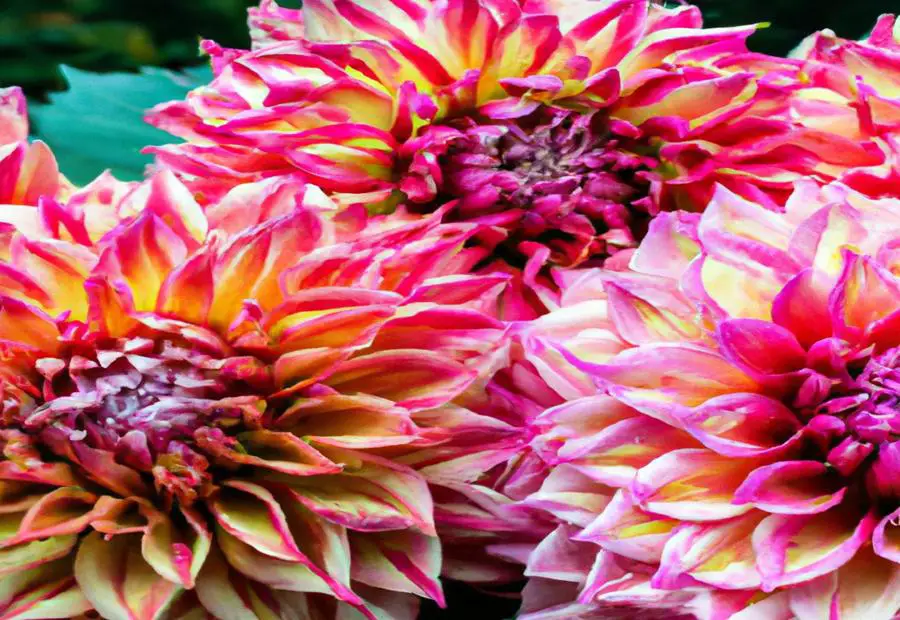
Photo Credits: Fortheloveofgardeners.Com by Steven Clark
Caring for dinner plate dahlias is essential to ensure their healthy growth and abundant blooms. In this section, we will cover the key aspects of care and maintenance that will help you enjoy stunning dinner plate dahlia flowers in your garden. From finding the right height and placement in the garden to overwintering in colder climates, as well as preventing pests and diseases, and even tips for creating striking large-scale floral arrangements, we’ve got you covered for all your dinner plate dahlia care needs.
Height and placement in the garden
Dinnerplate dahlias require the right height and spot in the garden for ideal growth and attractiveness. The following guide will show you how to find the best height and placement:
- Step 1: Decide the height
- Step 2: Choose a spot
- Step 3: Place in the garden
- Step 4: Think of winter
These dahlias generally grow to at least 4 feet tall. This height makes them great for adding drama to your garden or flower bed.
Pick a spot in your garden that gets full sun all day. These dahlias love it and it encourages good growth and blooms. Make sure the soil is well drained to avoid waterlogging and issues.
Put them at the back of the flower bed or create a cutting garden for them. That way their tall stems can be seen without blocking smaller plants.
If winters are cold, you might need to dig them up and store them indoors. This will protect them from frost and let you enjoy them again next year.
Also, you may have noticed large floral arrangements in the above sections. Dinnerplate dahlias are made for these arrangements because of their size and colors.
Now you know how to add dinnerplate dahlias to your garden with the right height and placement. They will be a standout feature of your outdoor space.
Growing to at least 4 feet tall
- Sunlight: 6-8 hours of direct sunlight a day. Plant in a spot with uninterrupted sun!
- Soil: Well-drained soil is essential. Amend with compost or aged manure.
- Watering: Give an inch of water per week, either from rain or irrigation.
- Support: Stake and tie the stems as they grow to prevent damage.
- Deadheading: Cut off faded blooms to redirect energy to new growth.
Follow these steps and enjoy the gorgeous height of dinnerplate dahlias!
Placing at the back of flower bed or in a cutting garden
Puttin’ dinnerplate dahlias at the back of a flowerbed or cuttin’ garden is a smart move. It gives ’em optimal impact and easy access for pickin’ blooms as decoration.
- At the back of a flowerbed, they make a gorgeous backdrop with their large, vibrant blooms.
- In a cuttin’ garden, they can add height and drama without overshadowing.
- Their positioning makes it convenient for pickin’ flowers for bouquets and centerpieces.
- Their height makes ’em visible from a distance, so they can make a pretty composition with other plants in the foreground.
- Dinnerplate dahlias can reach 4 feet tall, so they’re perfect for placin’ at the back.
When designin’ your flowerbed or cuttin’ garden, keep in mind the size and stature of dinnerplate dahlias. At the back, they can look beautiful without blockin’ other plants. Plus, it’s easy to pick the blooms for decorations.
Overwintering in cold climates
Protecting dinnerplate dahlias in cold climates is key. They’re sensitive to freezing temperatures and can be killed if exposed to cold for too long. To ensure their survival, store them indoors during winter months.
- Dig up the tubers once the foliage has died after the first frost.
- Remove excess soil and trim any remaining green growth.
- Place the tubers in a well-ventilated area to dry for a few days before storing them.
- Use materials like peat moss or vermiculite to pack the tubers for insulation and air circulation.
Keep the tubers in a cool, dry, and dark location. The ideal temperature is 40-45°F (4-7°C). Avoid storing near fruits or veggies that emit ethylene gas, as it can cause sprouting or decay. Check the tubers regularly, discard any with signs of rot or damage.
With proper overwintering techniques, dinnerplate dahlia health and vigor can be preserved. By providing them with a protective indoor environment, gardeners can enjoy these beautiful flowers year after year.
Need for storing indoors during winter
Dinnerplate dahlias need love to bloom vibrantly! This means they must be stored inside during winter. Frost can ruin them in cold climates.
- To keep dinnerplate dahlias safe, they must be taken inside before the first frost kills the foliage.
- Dig up the tubers, clean and dry them.
- Store them in a cool, dry area below 50°F (10°C).
Storing the tubers indoors helps protect them from rotting or drying out. This way, they can survive until the next spring.
In conclusion, storing dinnerplate dahlias indoors during winter is key to their survival in cold climates. This ensures gardeners can enjoy their beauty year after year.
Pest and disease prevention
Gardeners can take preventive measures to ensure their dinnerplate dahlias are healthy and flourishing. One effective method is to create a physical barrier or apply insecticidal soap to deter pests like Japanese beetles. Providing proper air circulation around the plants by spacing them appropriately is also important to reduce the risk of fungal infections and other diseases.
In addition, removing any diseased or infected plant material promptly can help prevent the spread of diseases. Regular inspections of the plants for signs of pests or diseases allows for early detection and intervention. Choose disease-resistant varieties of dinnerplate dahlias whenever possible to increase resistance to common dahlia diseases.
These steps will help ensure dinnerplate dahlias thrive in the garden, free from pest infestations or disease outbreaks. Neglecting this aspect of care may result in stunted growth, damaged foliage, reduced flower production, or even complete loss of plants. Therefore, being vigilant in monitoring for potential threats is essential for a successful dahlia garden.
Protection against pests like Japanese beetles using physical barriers or insecticidal soap
Dinnerplate dahlias, renowned for their grand size and beauty, can be vulnerable to Japanese beetles. To protect these stunning blooms, physical barriers like netting or mesh can be used to shield them from pests. Insecticidal soap is also an effective method for repelling these insects. It is crucial to prioritize the protection of these dahlias to preserve their health. To further deter Japanese beetles, plant flowers and herbs such as marigolds, catnip, and tansy near the dahlias. With these precautions, you can create magnificent floral arrangements with your dinnerplate dahlias and keep them looking their best.
Tips for large-scale floral arrangements
Creating large-scale floral arrangements? You can impress with these tips!
- Choose dinnerplate dahlias with different colours and sizes, to add visual interest.
- Then, arrange them from tallest to shortest for a pleasing look.
- Include other flowers or foliage for a variety of textures and shapes.
- Pick dahlias that complement each other for the colour scheme.
- Ensure the container or vase is big enough for the dahlias.
- Start with a focal point and build around it.
- Remember to change the water regularly, as dahlias need hydration.
- Make the most of this chance to show off your creativity.
- With care, dinnerplate dahlias become stunning displays.
- So, let your imagination run wild! Perfect for weddings or feeling like royalty.
Ideal for centerpieces and flower arches
Dinnerplate dahlias: an ideal choice for centerpieces and flower arches! Their size and vivid colors make them a captivating sight, and the variety of shades available offers endless arrangements. Plus, their sturdy stems make them easy to work with and their long vase life keeps them vibrant. Don’t miss out on these beautiful blooms to make your event unforgettable! Enhance it with awe-inspiring centerpieces and enchanting flower arches that will leave your guests speechless. Embrace the elegance and charm of dinnerplate dahlias!
Popular Varieties of Dinnerplate Dahlias
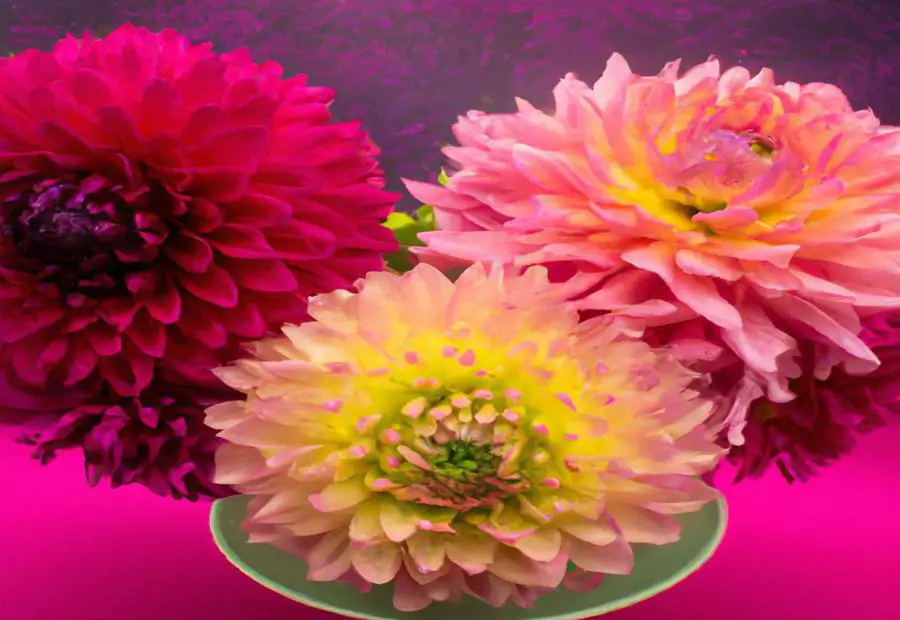
Photo Credits: Fortheloveofgardeners.Com by Ronald Rodriguez
Dinnerplate dahlias are a hit with flower fans! Their huge, impressive blooms come in all shapes, sizes and colors, making them a great choice for any garden or flower display.
One popular variety is ‘Café au Lait’. Its beige to blush-pink petals are huge – a favorite among brides and florists.
The ‘Kelvin Floodlight’ is also in demand. It has bright yellow blooms up to 10 inches in diameter. Plus, its long vase life makes it great for cut flower arrangements.
The ‘Thomas Edison’ has deep, rich purple petals. Up to 8 inches in diameter, they add drama and elegance to any garden.
Dinnerplate dahlias also draw pollinators like bees and butterflies, thanks to their nectar and colors. Plus, they flower from mid-summer to the first frost.
To get the best from your dinnerplate dahlias, plant them in full sun and well-drained soil. Give them support like stakes or cages so the big blooms don’t flop over. And regular deadheading will keep them looking great.
In summary, dinnerplate dahlias are amazing. Their size, colors and long flowering period make them a must-have! Choose popular varieties like ‘Café au Lait’, ‘Kelvin Floodlight’ and ‘Thomas Edison’. With the right care, you’ll enjoy their beauty all season.
Conclusion

Photo Credits: Fortheloveofgardeners.Com by Ryan Smith
To finish, dinner plate dahlias are a gorgeous addition to any garden. Their huge, vivid blooms make them a must-have for gardeners and flower lovers. These dahlias are known for their one-of-a-kind dinner plate-sized flowers, which can measure up to 12 inches across. They come in a wide range of colors, including pinks, purples, oranges, and yellows. When planting dinner plate dahlias, pick a sunny spot with well-drained soil. They need regular watering and benefit from fertilizer. With the right care, dinner plate dahlias can provide a lovely display of color all summer long.
Also, dinner plate dahlias offer practical benefits. They attract pollinators such as bees and butterflies, which help with plant reproduction and the overall health of the garden. The big flowers can also act as a natural windbreak, protecting more fragile plants from powerful gusts of wind. Plus, dinner plate dahlias are fairly easy to take care of, so they’re great for both experienced and rookie gardeners. With their breathtaking looks and practical benefits, it’s no wonder dinner plate dahlias are a popular pick for those wanting to add a touch of beauty to their outdoor areas.
Some Facts About Dinner Plate Dahlia Flower Guide:
- ✅ Dinner Plate Dahlias are the largest varieties of dahlia flowers, with blooms that are 8″-12″ wide and resemble the size of a dinner plate. (Source: Home for the Harvest)
- ✅ Popular varieties of Dinner Plate Dahlias include Café Au Lait, Kelvin Floodlight, and Labyrinth. (Source: Home for the Harvest)
- ✅ Dinner Plate Dahlias start blooming in July and continue until the first hard frost in October. (Source: Home for the Harvest)
- ✅ These flowers grow on bushy, tuberous, herbaceous perennial plants native to Mexico and Central America. (Source: Home for the Harvest)
- ✅ Dinner Plate Dahlias are ideal for large-scale floral arrangements such as centerpieces and flower arches. (Source: Home for the Harvest)
FAQs about Dinner Plate Dahlia Flower Guide
Can dinner plate dahlias be forced to bloom early for a wedding in early June?
According to the reference data, starting dinner plate dahlias in pots can allow for earlier blooming. However, it is important to plant them outdoors after the danger of frost has passed. Therefore, it is possible to have dinner plate dahlias in full bloom for a wedding in early June by starting them early in pots and then transplanting them outdoors at the appropriate time.
How can I identify the specific variety of my seed dahlias?
The reference data states that seed dahlias can produce different varieties. To identify the specific variety of your seed dahlias, it is recommended to refer to the National Dahlia Society or consult with an expert in dahlias who can provide more information on specific varieties.
What are the signs that a dahlia plant needs dividing?
The reference data mentions several signs that indicate a dahlia plant may need dividing, including a doughnut-type hole in the center, lots of foliage but few flowers, stunted growth, and yellowish leaves. If you notice these signs in your dahlia plant, it is likely time to divide it.
What is the recommended planting time for dinner plate dahlias?
According to the reference data, dinner plate dahlias should be planted outdoors in the spring after the danger of frost has passed and the soil is warm. This will provide them with the ideal conditions for growth and blooming.
What are the largest varieties of dahlia flowers?
The reference data states that dinner plate dahlias are the largest varieties of dahlia flowers. These flowers measure 8″ to 12″ wide, resembling the size of a dinner plate. They create extravagant summer bouquets and are ideal for large-scale floral arrangements.
How often should dinner plate dahlias be fertilized?
According to the reference data, dinner plate dahlias are heavy feeders and should be fertilized every 2-3 weeks with a general-purpose fertilizer. Regular fertilization will provide them with the necessary nutrients for optimal growth and blooming.

A passionate gardener and founder of ForTheLoveOfGardeners.com. She shares her expertise to help you cultivate thriving gardens and find joy in the beauty of nature.
